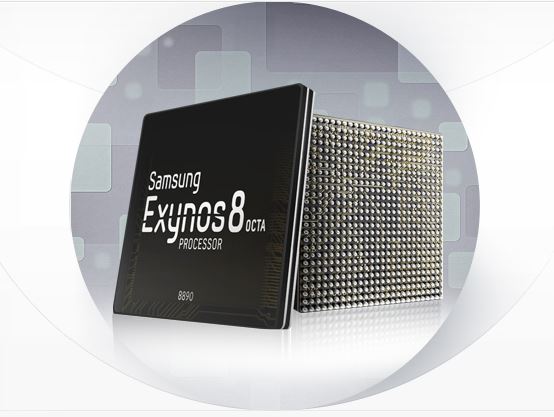Exynos 8 Octa Brings Samsung's First Custom ARMv8-A CPU Core, Integrated LTE
Samsung unveiled that its next-generation System on Chip (SoC), the Exynos 8 Octa (8890), will ship with the company's first-ever custom CPU core built on the 64-bit ARMv8-A architecture. The chip will also integrate a latest-generation Release 12 Cat. 12/13 LTE modem, just like Qualcomm's Snapdragon 820.
"The Exynos 8 Octa is a leading-edge application processor for next-generation mobile devices that incorporates Samsung's mobile technology leadership in CPU, ISP, and modem as well as process technology," said Dr. Kyushik Hong, Vice President of System LSI marketing, Samsung Electronics. "With our custom-designed CPU cores and the industry's most advanced LTE modem, consumers using mobile devices with the Exynos 8 Octa will experience a new level of mobile computing."
The previous generation SoC, the Exynos 7420, came with eight cores (four ARM Cortex-A57 and four ARM Cortex-A53) using the big.Little configuration. The new one comes with a similar design and also includes four Cortex-A53s for the lower-end tasks, but for higher-end tasks, four new unnamed custom cores from Samsung will be used.
Samsung claimed that the new chip will be 30 percent faster than the Exynos 7420, while using 10 percent less power. The chip also supports enhanced heterogeneous multi-processing for the efficient usage of the eight cores, which means all eight cores could be used at once for some tasks.
This is a feature of big.Little that Samsung has been using for a while. However, so far it hasn't been made clear if big.Little brings any efficiency improvements for everyday use of a smartphone. Qualcomm, even with its next-generation chip, which was built from the ground up, hasn't adopted big.Little, nor has it started using eight cores in its high-end flagship chip, the Snapdragon 820.
The new Exynos 8 Octa will also bring ARM's latest Mali-T880 GPU, which is supposed to be 80 percent faster for the same power consumption level, or 40 percent more efficient if the performance level is kept the same as the Mali-T760. Samsung will likely choose a middle ground to both raise the performance and lower power consumption compared to the Mali-T760.
Samsung claimed that the new GPU will support 4K UHD (4096x2160) and WQUXGA (3840x2400) display resolutions, which may be a hint that we'll see a Samsung phone with a 4K display in 2016. However, it's more likely we'll see it on the Note 6 than on the Galaxy S7.
Get Tom's Hardware's best news and in-depth reviews, straight to your inbox.
So far, the Sony Xperia Z5 Premium is the only phone with a 4K display, but it only presents some content at its full 4K resolution and scales the rest down to 1080p. The advantages of 4K displays on a smartphone already seem to be minor at best, but when it's not even fully utilized, then it just becomes another marketing bullet point, while also having a significant negative impact on performance, battery life and device cost.
The new Exynos 8 Octa will also bring an embedded Release 12 LTE modem, which promises a download bandwidth of up to 600 Mbps and an upload bandwidth of up to 150 Mbps.
Samsung said the new chip will be manufactured on a 14nm FinFET process, but it didn't specify if it's the Low Power Early (LPE) generation or the Low Power Plus (LPP) one, which should offer slightly better power consumption characteristics to the chips. The mass production of the Exynos 8 Octa will begin in late 2015, which means we can expect it in the next Galaxy S7 (or at least some versions of it).
______________________________________________________________________
Lucian Armasu joined Tom’s Hardware in early 2014. He writes news stories on mobile, chipsets, security, privacy, and anything else that might be of interest to him from the technology world. Outside of Tom’s Hardware, he dreams of becoming an entrepreneur.
You can follow him at @lucian_armasu. Follow us on Facebook, Google+, RSS, Twitter and YouTube.
Lucian Armasu is a Contributing Writer for Tom's Hardware US. He covers software news and the issues surrounding privacy and security.
-
alextheblue "Qualcomm, even with its next-generation chip, which was built from the ground up, hasn't adopted big.Little, nor has it started using eight cores in its high-end flagship chip, the Snapdragon 820."Reply
Lawlwut? Qualcomm has been using big.LITTLE for a while now, and they CONTINUE to do so with the 820. Search engines people... they're not just for porn anymore! -
alextheblue Actually now I'm not certain on the Kryo powered 820. They might be homogeneous in terms of core design but not certain what they're doing in terms of voltage and clocks. I've read mixed things. I'd even count chips like the 615 as being big.LITTLE conceptually, if not literally. For example the 615 has 4 lower-clocked lower-power cores and 4 higher-clocked ones. They're the same cores, but the differences in power and clockspeed make them heterogeneous in practice.Reply
But for certain the 618, 620, 808, and 810 are all big.LITTLE by any measure. -
Lucian Armasu @alextheblue I only said Qualcomm didn't adopt big.Little for its high-end next-generation chip. It's true it used it in Snapdragon 810, but I wasn't talking about it.Reply

